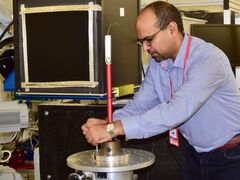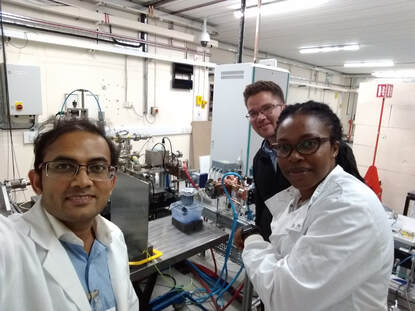 Manoj preparing samples prior to the imaging at Diamond Light Source. Image credit: Professor Ed Rhodes, University of Sheffield Manoj preparing samples prior to the imaging at Diamond Light Source. Image credit: Professor Ed Rhodes, University of Sheffield For millions of people across the globe, rice is the foundation of their diet. But this particular crop can contain unsafe levels of arsenic: a poisonous mineral that can cause death. One project funded by the STFC Food Network+ is seeking to understand how exactly arsenic accumulates in rice, which could ultimately inform safer production and cooking practices. Arsenic naturally occurs in underlying rock, particularly in the regions that border the Himalayan mountain range such as India and Bangladesh. This means that arsenic can easily contaminate groundwater in these regions. “Most people in these regions are aware that they shouldn’t drink water contaminated with arsenic” says Manoj Menon, a lecturer of environmental soil science at the University of Sheffield. “But there is a wider issue of arsenic accumulating in the food chain. Rice is especially problematic because it is a very thirsty plant that takes up a lot of water”. Indeed, for typical paddy-field style irrigation systems, it takes an estimated 2,500 litres of water to produce a single kilogram of unmilled rice. Furthermore, for many countries in south Asia, the average daily rice consumption can be as high as 500g-700g per day (pre-cooked weight), compared with just 15g for Europe. Clearly, this issue needs a holistic approach where crop breeding, irrigation schemes and cooking methods are all optimised to reduce arsenic contamination in rice. But before this can start, many fundamental gaps in our understanding need to be answered. Manoj began this task by asking how arsenic is distributed within the rice grains themselves – does it concentrate in particular regions or is it present throughout? To answer this, he turned to the UK’s national synchrotron Diamond Light Source, based at the Science and Technology Facilities Council’s Rutherford Appleton Laboratory. Diamond works like a giant microscope, but is 10,000 times more powerful than traditional models. It harnesses the power of electrons by accelerating them to near-light speeds, so that they give off light a billion times brighter than the sun. The light is directed into laboratories known as ‘beamlines’, where it is used to study anything from viruses and vaccines to ancient scrolls and jet engines. “Our samples were longitudinal sections of individual white rice grains, less than a millimetre thick” says Manoj. Using the X-ray beamline, Manoj produced a high-resolution map comparing the distribution of arsenic with other compounds. Crucially, arsenic was mostly concentrated around the outer layers of the grains. The essential nutrient zinc, on the other hand, was present around the embryonic part of the seed. “This fits previous works and also suggests that arsenic levels could be reduced without affecting the abundance of important micronutrients. This could be through refining the polishing process that removes the outer bran layer, or through alternative cooking methods”. Following this, Manoj investigated how arsenic levels varied across different rice cultivars and genotypes. His range of samples covered 55 different varieties, including both wild rice and supermarket brands. “We looked at brown rice, white rice, long grain, short grain, medium grain, organically produced and non-organically produced” says Manoj. Since it took between eight and nine hours to produce each high-resolution map using the Diamond Light Source, Manoj used classic analytical techniques to allow a faster comparison: Liquid Chromatography and Mass Spectrometry. Reassuringly, the results showed that for most of the samples, the levels of arsenic fell well below the European safety threshold for adults of less than 0.25 milligrams per kilogram. However, many of the samples exceeded the threshold for children, who have a much lower safety limit of 0.1 milligrams per kilogram. “In particular the highest arsenic levels were seen in organic rice samples” says Manoj. The results also confirmed previous studies which found that brown rice has higher arsenic levels than white. But Manoj cautions against avoiding brown rice on this principle: “Brown rice has health benefits not found in white rice, including higher levels of fibre, vitamins and minerals”. Since these initial results, the project has taken on a momentum of its own. “After this work with the STFC Food Network+, we have secured additional funding from the Global Challenges Research Fund, which allowed us to set up an Arsenic in Rice Research Network (ARRNet)” Manoj says. He is currently using this to investigate how different cooking methods may affect the distribution of arsenic, besides conducting surveys to understand how aware people in India and Bangladesh are of arsenic contamination in rice. A rice field experiment has been planned in India in 2020-21 to optimise irrigation practices. “Our long-term goal is to apply this knowledge in these regions to help people live with arsenic in the environment” Manoj says. “This initial small grant from the STFC Food Network+ acted as a spark that has really changed my life a lot” he adds. “It is a brilliant initiative to have small pots of money available that are easier for researchers to access than big grants with more competitive and lengthy application processes. This helps to get projects started”. Despite his work, he still enjoys a good plate of rice, and advises that Europeans shouldn’t be too worried about arsenic contamination. “Our message is that it is the total amount of rice you eat that is the main risk factor” he says. “For the average consumption rate of Europeans, arsenic contamination shouldn’t be a problem, although it is perhaps best to restrict how much rice children are given”. Manoj and his team have had two papers published on this project: Menon et al (2020) Do Arsenic levels in rice pose a health risk to the UK population? Ecotoxicology and Environmental Safety Menon et al (2020) Improved rice cooking approach to maximise arsenic removal while preserving nutrient elements
1 Comment
 Scoping project team (University of Surrey and STFC Daresbury) working at the Compact Linac facility, STFC Daresbury laboratory. (Photo Credit Devendra Saroj) Scoping project team (University of Surrey and STFC Daresbury) working at the Compact Linac facility, STFC Daresbury laboratory. (Photo Credit Devendra Saroj) Across the world, many communities are already experiencing increasing droughts due to climate change. As the global population increases, securing enough supplies of clean, safe freshwater is a critical priority and using our current resources more efficiently needs to be part of this. Since farming is one of the largest consumers of freshwater, reusing waste water within agriculture could have a significant impact, however existing techniques are limited and difficult to apply at scale. But exciting pilot studies funded through the STFC Food Network+ are already bearing fruit – quite literally – in finding an alternative approach. “The novel aspect of this project is that we are using an established technique for a purpose it has never been used for before - to purify waste water” says project lead Devendra Saroj, Head of the Centre for Environmental Health and Engineering at the University of Surrey. The main issue with using waste water from industrial sources within agriculture is the presence of contaminants which can then accumulate in plants and seeds. Devendra’s approach is based on treating waste water with pulses of electrons that will react with organic compounds and instantly degrade them. Similar electron beams are already used widely in other applications, such as the security and health sectors. “Ultimately, using electron beams could purify wastewater to a very high standard within minutes” Devendra says. This is in stark contrast to existing membrane-based purification methods which can take several hours. His initial results on wastewater samples from textiles and mixed industrial uses are already promising, with over 95% of organic compounds being removed. “This is on a par with conventional techniques but much faster” Devendra says. To assess whether this water could safely be used for agricultural purposes, the team have been testing the purified water on plants (such as lettuce and beans) grown in petri dishes. Reassuringly, the results showed little difference between tap water and the purified wastewater, with the seedlings appearing completely healthy with no growth defects. “We are now talking with companies who specialise in hydroponic growing systems, to test this water on vegetables grown commercially” says Devendra. “Since these are closed agricultural systems, these could potentially be coupled to places where waste water is generated”. Another long-term goal is to use wastewater from actual farms, for instance to purify water containing run-off from organic fertilisers. But the immediate issue is to scale-up the process, since the current bench-size prototype model is only capable of handling sizes up to a litre. This may require a fundamental shift in production processes as Devendra explains: “Most electron beam applications are for scientific uses in laboratory settings. Manufacturers will have to adapt the instruments if they are to be used mainstream”. With so many factors to consider, including cost, ease of use and electron beam concentration, these proof-of-concept results will play a key role in convincing manufacturers to take up the challenge. For Devendra, the project illustrates perfectly the STFC Food Network’s goal of catalysing new ideas through bringing different disciplines together. “I would encourage researchers to participate in the network, even if they don’t see an immediate connection to their work” he says. It was through one of the Food Network’s Sandpit events, for instance, that he met physicists who develop accelerators that create electron beams. “They hadn’t thought of using this technology in an application like water recycling but with my environmental background I saw the opportunity” Devendra says. “I enjoy actively participating in the STFC Food Network because it allows me to bring my skills and contribute to areas that I don’t have specific expertise in, such as climate change. Bringing different disciplines together allows problems to be addressed from different angles”. With particular thanks to Dr Donna Pittaway at STFC Daresbury Laboratory |
AuthorJune 2024 - Archives
June 2024
Categories |
- Home
- Webinars and Events
- About the SFN+
- News
- Blog
- Expert Working Groups
- Funding
-
Publications
- Bioeconomy positioning paper
- SFN+ 5th Annual Conference
- OMM Policy Report
- ‘Multi-Stakeholder International One Day Workshop on Organic Agri-Food Value Chains for Net Zero’ Report
- SFN 2050 UK Net Zero Food report
- Sustainable Cold Food Chain Booklet
- Food Sensing Technologies for Safe and Nutritious Food
- Sustainable urban and vertical farming
- Projects
- Join/Contact Us


 RSS Feed
RSS Feed


